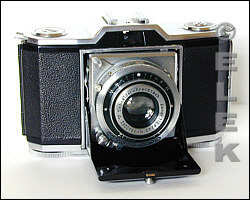Zeiss Ikon Ikonta 35

|
|
|
| Style, film format | Folding fixed-lens zone-focus 35mm |
|
|
|
| Lens, shutter | Schneider-Kreuznach 45mm f/2.8 Xenar, Compur-Rapid |
|
|
|
| Photo quality | Depends on the lens |
|
|
|
| Ergonomics | Good, front-mounted shutter release |
|
|
|
As Zeiss Ikon took stock of what was left of the company following massive Allied bombing that demolished its factories, it also had to contend with the division of Germany. Its camera-making plants were in the East zone, while much of the rest of the operation was in the West zone.
This was one of the first efforts to come out of the Stuttgart facility: A small folding camera that first was called the Ikonta and later renamed the Contina I. It was the platform upon which Zeiss Ikon's Contina II and Contessa were built.
Because of the scarcity of lenses, some of the early Ikontas used a Schneider-Kreuznach 45mm f/2.8 Xenar lens in a Compur-Rapid shutter. Subsequent models have the Novar with a Prontor shutter, while others are fitted with one of two Tessar versions and a Compur shutter. The edge sharpness of photos will vary according to the lens and the aperture. The Novar often is a bit soft in the corners, while the Tessar and Xenar will give round out-of-focus backgrounds when shot wide open.
This camera has a front-mounted shutter release, which needs care when pushed, because you tend to push the camera down with it. The best way to hold any of the the Zeiss Ikon folding camera is to support it with the palm of your left hand while peering through the viewfinder.
The camera is much lighter than the Contina and lighter by several factors than the Contessa. It uses a simple viewfinder and has neither a meter nor a rangefinder. Focusing is by "your best guess."
When folded, the camera is highly pocketable. It's an excellent little camera.
